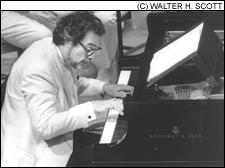
BEATS AS UPWARD SPRINGS: None of Artur Schnabel's students more fully embodied his extraordinary rhythmic swing than did Leon Fleisher - and he still does.
|
I’ve been holding my breath ever since Leon Fleisher postponed his February FleetBoston Celebrity Series recital. Now I can finally exhale. Forty years ago, at the height of his career, Fleisher came down with what was finally diagnosed as dystonia — cramps or involuntary muscle contractions, in his case in the fingers of his right hand. He continued to play music for the left hand and started conducting. In 1995, he returned to playing with both hands, though in a relatively small repertoire. Now 75, he’s on the board of Musicians with Dystonia, and he wants his story known. Fleisher was widely regarded as one of the very greatest pianists America had produced. At the age of nine, he became a student of the legendary Artur Schnabel, who never took pupils under 16. Schnabel taught him that musical values had to transcend technique, that there were feelings behind the notes. In a 1999 interview, Fleisher vividly recalled the "irresistible swing" of Schnabel’s playing: "He would in effect distort time to . . . underline the character that he was trying to bring out. Beats were never downward events, they were not like fence posts or the hammering of coffin nails — beats were upward springs that would spring you on to the next beat." None of Schnabel’s students more fully embodied this extraordinary rhythmic swing. At Jordan Hall, Fleisher once again demonstrated that gift for continuity. The first half of the program started and ended with Bach, but in between he delivered a recital of 20th-century American music — works by friends and even a former student, Diana Koston, now in her 60s. Koston’s Messages I doesn’t break any new ground, but its vivid contrasts (fluttering like an injured bird followed by something mole-like making its slow way through a dark tunnel), some reverberating pedal effects, and Fleisher’s sensitive pacing and subtleties of coloration made it come alive. Two left-hand pieces made an illuminating comparison. George Perle’s witty, hypnotic, coolly analytic Musical Offerings for the Left Hand Alone (1998) is a tribute to three of Fleisher’s former colleagues when he served as artistic director of the Tanglewood Music Center: Richard Ortner (now head of the Boston Conservatory), who was removed by Seiji Ozawa, and Daniel Gustin and pianist Gilbert Kalish, who resigned — with Fleisher — in protest. On the other left hand, Leon Kirchner’s touching 1995 Music for the Left Hand is emotive, improvisational, dreamlike, tender, and yearning rather than cerebral, full of thunderous or gently rapturous chords rather than Perle’s rippling DNA strands of notes. (At the Gardner Museum, young Jonathan Biss recently played Kirchner’s reworked version for both hands.) Making few concessions to popular appeal, Fleisher concluded his "modern" section with Roger Sessions’s concise, knotty From My Diary. He played these all with the deepest affection and concentration. The opening Bach was Egon Petri’s piano transcription of the heavenly "Schafe können sicher weiden" ("Sheep May Safely Graze"), Pales’s aria from Cantata No. 208; the closing was the great Chaconne from Bach’s D-minor Partita for solo violin, powerfully transcribed by Brahms. The rigor and clarity, passion and beauty of Fleisher’s performance of the Chaconne offered the full, compelling continuum of this profound and challenging movement. Fleisher clung to the underlying theme as if he were riding a wave — by the end, one understood every implication. I almost wish he had replayed "Schafe können sicher weiden," which, however lovely, seemed less divine than detached, with an almost clinical interest in the left-hand harmonies rather than in Bach’s exquisite tune. The major work was Schubert’s B-flat Sonata D.960, one of the supreme pieces of piano music — rediscovered by Schnabel, who made the very first recording. From the very first phrase, Fleisher made this his own. Here was that sense of forward momentum, but with a heartbreaking intimacy in the phrasing, a kind of whispered conversation with someone you couldn’t see but whose presence you felt. This is music that is both a revelation of "the tears for things" and a consolation for those tears. The slow movement is a kind of barcarole, a gently rocking lullaby of piercing sadness. Fleisher played it very slowly, as a kind of transport, an out-of-body experience. The scherzo was of a mingled yarn — a buoyant yet shadowy celebration. In the vigorous finale, Fleisher’s fingers didn’t always land in the right place, but it was an exhilarating and dramatic conclusion. Fleisher returned for curtain calls and standing ovations. He quieted the applause and explained that no music could follow this sonata. Schnabel, he told us, never gave encores, saying he "always thought that applause was a receipt, not a bill." Received, from Leon Fleisher, with thanks, one unforgettable concert.
page 1
page 2
|

